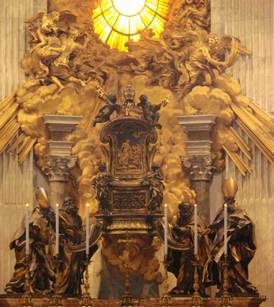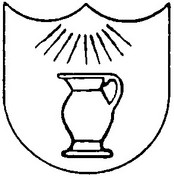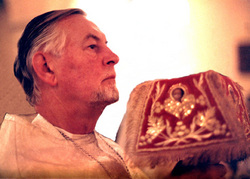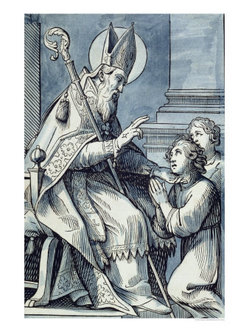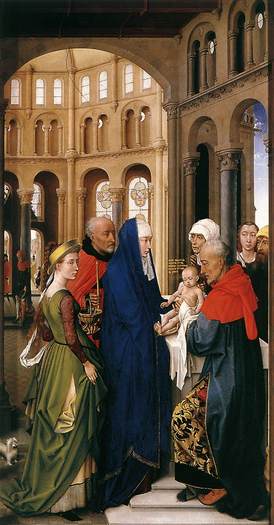This past Sunday, the Church gathered to worship God; she observed the Presentation of teh Lord in the Temple; and she observed 25 years of priestly service to the Divine Majesty of one her sons, The Reverend Father Richard G. Cipolla, PhD, DPhil (Oxon). Father Cipolla is a priest of the Diocese of Bridgeport, CT, a teacher, a husband, the father of two, and a great friend. We were colleagues at Fairfield Prep (Fairfield, CT) in late 1990s and I served the Mass he celebrated faithfully at the Bridgettine Convent (Dairen, CT). The homily Father Cipolla delivered on Sunday follows. It bears reading and using for today's lectio.
Candelmass, 25th Anniversary Mass, 1 February 2009, St Mary's Norwalk
 She wraps him carefully, carefully against the cold, not the cold of a New England winter, but cold nevertheless. And as she wraps him she ponders all these things in her heart. And when all is ready she and her husband bring him to the temple, that the law may be fulfilled. And they bring their thank-offering for the birth of their son. They bring him to the temple to dedicate him, to redeem him as the first born with their little gift, meant to be a symbol and yet everything. As they enter the darkened temple the lamp burning before the holy of holies flickers, flickers in recognition of the reality replacing the symbol, the flesh of God enters the place of the symbol of God, and reality is changed, the warp and woof of the universe of space-time explodes silently, as the creator of space-time enters into the man made temple and shatters forever the disconnect between human history and the eternal God.
She wraps him carefully, carefully against the cold, not the cold of a New England winter, but cold nevertheless. And as she wraps him she ponders all these things in her heart. And when all is ready she and her husband bring him to the temple, that the law may be fulfilled. And they bring their thank-offering for the birth of their son. They bring him to the temple to dedicate him, to redeem him as the first born with their little gift, meant to be a symbol and yet everything. As they enter the darkened temple the lamp burning before the holy of holies flickers, flickers in recognition of the reality replacing the symbol, the flesh of God enters the place of the symbol of God, and reality is changed, the warp and woof of the universe of space-time explodes silently, as the creator of space-time enters into the man made temple and shatters forever the disconnect between human history and the eternal God.
And you notice that is not the high priest who recognizes this child. It is not the religious authorities who officially wait for the Messiah, the redeemer. They are probably watching their wide screen plasma TV in the rectory. It is the pious old man, Simeon, who waits in the temple for the reality, and who recognizes this reality, mirabile dictu, when he sees it and when he recognizes the reality he takes the child in his arms and sings, he sings in perfect chant: Nunc dimittis. Lord, now lettest thou thy servant depart in peace. For mine eyes have seen thy salvation. And he holds the child to himself, the child who is his creator, and he sees the suffering of this child as a man, he sees what redemption means, he sees the sword of suffering in the heart of the child's mother. He sees, he weeps, but he weeps with tears of joy.
The wreaths are long gone. The Christmas trees are part of the compost of town dumps. Our houses are bare, secular, waiting for the end of winter. And in the midst of all of this the Church demands that we celebrate the last feast of Christmas, the purification of St Mary the Virgin, commonly known as the Presentation of Christ in the temple, when we bless candles, reminding us that the child born on Christmas night is the light of the world. The world has forgotten Christmas until next Halloween. We, as St John reminds us, are not of the world, so we joyfully celebrate this last of the great Christmas feasts, a feast that is the climax of Epiphany, the feast that is one more answer to the question: who is this child? Who is this man? What does all of this mean? What is the cross? What is Easter? For mine eyes have seen thy salvation which thou hast prepared before the face of all peoples. Quite an affirmation. This is not theoretical or cultural Christianity, no pie in the sky business, no teddy bear in the sky God, no warm fuzzies. The astounding claim that the child that Simeon takes from Mary and holds in his arms is the Logos of the universe, the meaning of existence, the auctor of creation itself: this is at the heart of what the Christian faith is and what we do this afternoon is an antidote not only to the grey and boring secularism that marches on and tramples almost everything in its path but also is an antidote to that reduction of Christianity to right living, to morality, or to personal feeling that is grounded in an individualism that is contrary to the entire New Testament.
 When people ask me, as they have for over twenty five years, why did you become Catholic? They ask me this for various reasons, some good, some bad. But in the end what they want is for me to give some sort of personal journey story, something that I could do on Oprah, and would warm people's hearts. I am not adverse to warming people's hearts, but that has nothing to do with why I became a Catholic and remain a dedicated Catholic. Why I became Catholic is because it is real and therefore true; it is true and therefore real. Someone with my scientific background could never believe in anything that did not have a grounding in this world of atoms, of electrons, of muons, of the very stuff of the universe, of the stuff of which we are made. An idealistic religion, as some forms of American Christianity have become with all of the attendant corollaries, is something I could never ultimately take seriously. At least classical Judaism takes history seriously, seeing history through the lens of the relationship of God with the Jewish people, not the individual, but the people, the collective, the community. Here the God of Israel is engaged with his people, to say the least, chastising them, goading them on, calling them back, but never less than real in their own history. History. This is the key. Cardinal Newman said: to know history is to cease to be protestant. Now saying this I emphasize my debt and my love for my protestant upbringing which gave me a knowledge of the Bible and which set me upon my path. But when I found out that the Bible has a history and that history is inseparable from the oral tradition of the Church and the living teaching magisterium of the Church beginning with St Paul down to today. When I found out that Christianity has a history and that history is inseparable from the human history of the past two thousand years and that the Church is imbedded and inseparable from that history, then one is forced to the conclusion that either God entered human history with the birth of Christ and therefore the very stuff of human history is forever transformed, or the whole thing is a nice story that gives us a vague hope that Kafka is not right and that we do not die like a dog.
When people ask me, as they have for over twenty five years, why did you become Catholic? They ask me this for various reasons, some good, some bad. But in the end what they want is for me to give some sort of personal journey story, something that I could do on Oprah, and would warm people's hearts. I am not adverse to warming people's hearts, but that has nothing to do with why I became a Catholic and remain a dedicated Catholic. Why I became Catholic is because it is real and therefore true; it is true and therefore real. Someone with my scientific background could never believe in anything that did not have a grounding in this world of atoms, of electrons, of muons, of the very stuff of the universe, of the stuff of which we are made. An idealistic religion, as some forms of American Christianity have become with all of the attendant corollaries, is something I could never ultimately take seriously. At least classical Judaism takes history seriously, seeing history through the lens of the relationship of God with the Jewish people, not the individual, but the people, the collective, the community. Here the God of Israel is engaged with his people, to say the least, chastising them, goading them on, calling them back, but never less than real in their own history. History. This is the key. Cardinal Newman said: to know history is to cease to be protestant. Now saying this I emphasize my debt and my love for my protestant upbringing which gave me a knowledge of the Bible and which set me upon my path. But when I found out that the Bible has a history and that history is inseparable from the oral tradition of the Church and the living teaching magisterium of the Church beginning with St Paul down to today. When I found out that Christianity has a history and that history is inseparable from the human history of the past two thousand years and that the Church is imbedded and inseparable from that history, then one is forced to the conclusion that either God entered human history with the birth of Christ and therefore the very stuff of human history is forever transformed, or the whole thing is a nice story that gives us a vague hope that Kafka is not right and that we do not die like a dog.
The event we celebrate in this Mass, the presentation of Christ in the temple, is part of human history. If it is not, forget about it. It means nothing. And what we do together this evening is part of human history. It may not be observed by many people, just as the birth of Christ was observed by very few people, just as his death on the cross was observed by very few people, just as his post-resurrection appearances were observed by very few people. But nevertheless it is happening in this world in this place as a part of human history. And what we do here is the context of the Church's liturgy, in the context of the Mass. We are not just a bunch of people coming together to commemorate a religious festival, like the Romans did with Saturnalia. We are not here to ponder intellectually or mentally or heartfully what
 Christianity means. We do not come here to learn. We come here to connect and be connected to the pivot event of human history: the death and resurrection of the Lord of history. We come here to worship the God who is above his creation, eternal, all powerful, the ground of being, but who comes among us in the forms of bread and wine, stuff of the universe and pretty basic stuff at that, who comes to us in this church at this altar in this space and time, who comes as the Son to offer himself up to the Father in the eternal sacrifice that alone makes that connection between God and man possible and real. Simeon held the child Jesus in his arms. What a wonderful thing. But we go far beyond that. In this Mass the Son offers himself to the Father, Calvary is re-presented, and the infinite grace of that offering is bestowed upon us, and as we receive Holy Communion symbol and reality become one, as God enters our body to transform us from death into life. This is where worship and life come together. This is where culture and faith come together. This is where beauty and truth kiss, this is where eternity and time intersect. This is where those whom we have loved and who have died in Christ are with us in the most real way as part of the body of Christ. This is where the angels and archangels and the blessed Virgin Mary and all the saints join with us in this offering of sacrifice and praise.
Christianity means. We do not come here to learn. We come here to connect and be connected to the pivot event of human history: the death and resurrection of the Lord of history. We come here to worship the God who is above his creation, eternal, all powerful, the ground of being, but who comes among us in the forms of bread and wine, stuff of the universe and pretty basic stuff at that, who comes to us in this church at this altar in this space and time, who comes as the Son to offer himself up to the Father in the eternal sacrifice that alone makes that connection between God and man possible and real. Simeon held the child Jesus in his arms. What a wonderful thing. But we go far beyond that. In this Mass the Son offers himself to the Father, Calvary is re-presented, and the infinite grace of that offering is bestowed upon us, and as we receive Holy Communion symbol and reality become one, as God enters our body to transform us from death into life. This is where worship and life come together. This is where culture and faith come together. This is where beauty and truth kiss, this is where eternity and time intersect. This is where those whom we have loved and who have died in Christ are with us in the most real way as part of the body of Christ. This is where the angels and archangels and the blessed Virgin Mary and all the saints join with us in this offering of sacrifice and praise.
And all of this in sign and symbol that partake of the reality of God in this extraordinary form of the Roman rite. The ordinary form, the Mass of Paul VI, is known as that because it happens to be celebrated in most Catholic parishes today. That is what ordinary means. The form we celebrate here and now, given back to the Church by the courage and foresight of the present Pope, is extraordinary in the jargon of the Church. Extraordinary means here not exceptional but rather not ordinary. This is the rite that is the distillation of the Catholic faith of at least fifteen hundred years; this is the stuff of Catholicism, not man made, not the product of scholarship or committees, but rather the product of organic growth, like a wonderful old house with some funny and strange features, rooms that seem too small or too large, some curious old furniture, and yet when you step into it, you know that this is a home, a home that has been lived in by countless generations, a home that is meant to be enjoyed, contemplated, a place to have fun in, a place that is home in the sense that it is full of that love that makes a home a real home and not merely a house.
Some of you know the ending of TS Eliot's poem, "Little Gidding":
We shall not cease from exploration
And the end of all our exploring
Will be to arrive where we started
And know the place for the first time.
The first time I celebrated this form of the Mass, these lines came to me, for I knew this place for the first time as the place for which I was ordained a Catholic priest. And what I have come to realize is that the Traditional Mass has been given back to the Church by the grace of God in order that new generations might know the place for the first time in all its beauty and truth. For how many years was this place deformed by lifeless, legalistic celebrations of the Mass? How long was this place hidden from a laity consigned to being mere spectators at a clerical event? How long was the entrance to this home barred by those who refused to believe that the people of God were intelligent enough and faithful enough and graceful enough to live fully in this home and so built a new home to appeal to a generation that already has grey hair and is as outdated as is the Brady Bunch split level house? This form of the Mass has been given back to the Church as a gift, a gift to be shared, a gift to be cherished, a gift that lies at the very heart of what it means to be Catholic.
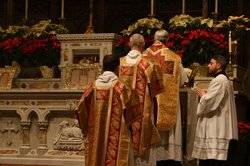 This task of renewal is indeed formidable. It is much more formidable than that which President Obama faces in this time of national crisis. The liturgical damage of the past forty years is deep; it is as high as a mountain, for it is not only a question of liturgical form, it is that mountain of willful ignorance that has confused worship of God with worship of the self. And there are days when I look at that mountain and say to myself that there is no way to return. But then I look at the great number of young children at the coffee hour following the 9:30 Solemn Mass on Sunday; I see them running around, I see them stuffing a doughnut into their mouths, I see them with their young parents who have brought them to the Mass, I see them as children whose only experience of Mass is precisely this what we do today, the worship of the transcendent God who became flesh: then the mountain does not seem as high. How fitting is that we celebrate this Mass in this church whose lack of an altar rail, whose absent side altars, whose soiled wall to wall carpet, all speak of the liturgical deterioration of the past forty years. And how fitting it is that this parish church, not one of the wealthy parish churches of this diocese, is determined to bring back the beauty of this church, not for beauty per se, but so that it can once again be a fit setting for the coming of God in the flesh to his people and their response of adoration.
This task of renewal is indeed formidable. It is much more formidable than that which President Obama faces in this time of national crisis. The liturgical damage of the past forty years is deep; it is as high as a mountain, for it is not only a question of liturgical form, it is that mountain of willful ignorance that has confused worship of God with worship of the self. And there are days when I look at that mountain and say to myself that there is no way to return. But then I look at the great number of young children at the coffee hour following the 9:30 Solemn Mass on Sunday; I see them running around, I see them stuffing a doughnut into their mouths, I see them with their young parents who have brought them to the Mass, I see them as children whose only experience of Mass is precisely this what we do today, the worship of the transcendent God who became flesh: then the mountain does not seem as high. How fitting is that we celebrate this Mass in this church whose lack of an altar rail, whose absent side altars, whose soiled wall to wall carpet, all speak of the liturgical deterioration of the past forty years. And how fitting it is that this parish church, not one of the wealthy parish churches of this diocese, is determined to bring back the beauty of this church, not for beauty per se, but so that it can once again be a fit setting for the coming of God in the flesh to his people and their response of adoration.
Heady stuff, you say. Quite far from the happy-slappy Catholicism most Catholics have know for the past forty years. Quite far from the liberal Protestantism that has joined forces with the secular steamroller, quite far from the radically individualistic evangelical Christianity that draws thousands to the mega-churches on a Sunday. Quite far from the generic American religion that is a cross between vestiges of Christianity and vague moral stirrings. Quite far indeed. As far as eternity. As far as infinity. The infinity of the Logos, of the reason that holds the universe together. The infinity of the God who did not need us yet created us of his will. But ultimately the infinity of love, the love that knows no bounds, no not any, even to death, even to death on a cross for us, pro nobis, death for life, my life, your life, the only infinity that means anything at all, the infinity that became finite in the womb of Mary for the sake of love.
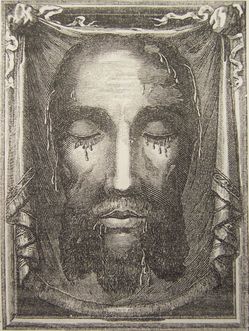 Today is Shrove Tuesday at last, or least I hope this is the beginning of a good, serious observance of Lent. The monks here have sung as many Alleluias as possible before they are packaged up and placed in the closet for 40 days (save an exception or two).
Today is Shrove Tuesday at last, or least I hope this is the beginning of a good, serious observance of Lent. The monks here have sung as many Alleluias as possible before they are packaged up and placed in the closet for 40 days (save an exception or two). 